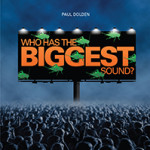Paul Dolden
Who Has the Biggest Sound
Starkland
If any composer is going to ask the musical question “Who has the biggest sound,” Paul Dolden is rightfully going to be on the short list of potential composers. The almost hour-long work Who Has the Biggest Sound is quite the whirlwind of sonic activity and stylistic diversity.
Relying mostly on high-quality samples instead of synthesized sounds, Dolden keeps a lot of humanity in the sound world. Rhythm and articulation are the only real means by which the artifice of his production shows through. One could imagine, for example, the overall sound world of “The Answer is Blowing in the Winds” being played totally acoustically but the hard edge to the attacks coupled with the dryness and clarity of the timbres makes it obvious to the ear that these are all processed sounds. This movement in particular comes across mostly like an instrumental version of Paul Lansky’s “chatter” pieces. Dolden’s journey through various ensembles at the start of the album hits its apex in the fifth movement “Who Can Play the Fastest?” Dolden started using rock instruments and tropes in the previous movement but in “Who Can Play the Fastest” he really, to be blunt, rocks the f—k out. It is glorious.
Unfortunately, Dolden kills this energy with the introduction of a narrator with hyper-exaggerated declamation while being mimicked in real time by instrumental samples. This overt asking of the music question brings an unwanted and unwelcome campiness to the piece and reduces most of the clean crisp instrumental samples into cheesy 90’s era MIDI samples. Who Has the Biggest Sound managed to have the right balance of levity and seriousness before the narrator started its aural mugging, the first 30 seconds of “My Hound is Out of Harmony” was going quite well before the narrator barges in, and for the rest of the piece Dolden seems obligated to pollute his otherwise engrossing creations with this whiny and irritating character. I love the idea of this musical question being posed by the “Center for Strategic Sound” but I think the implementation of the narration falls short. Humor is a tricky and subjective thing and something many composers avoid. Dolden’s attention to electroacoustic studio techniques reassures me that while he tries to be funny he takes his art seriously.
The Un-Tempered Orchestra fortunately presents its aural landscape without a verbal guide. Having composed diatonic melodies and harmonies, Dolden uses computer processing to retune and juxtapose his material through a wide variety of tuning systems. The end result is a blurred aural line between performance and processing; a work which in some ways could be played acoustically (from a timbre, rhythm, and instrumentation point of view) and a work which could only be done via intense computer analysis and transformation. I find “Orchestra 4” to be the most sonically satisfying, especially as female voices emerge from the elongated clouds of stretched notes. These six conjoined ruminations which form The Un-Tempered Orchestra never really build into a single shape or trajectory, at least not to my ear, but I nevertheless find the whole work compelling and the final cadential resolution rather satisfying.






















